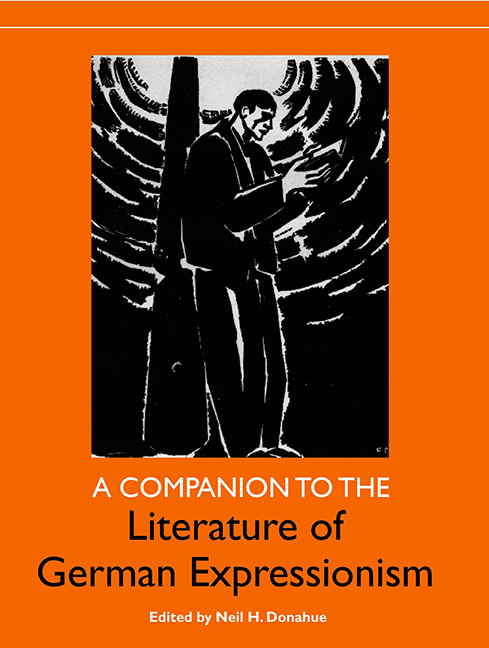Book contents
- Frontmatter
- Contents
- List of Illustrations
- Preface and Acknowledgments
- Chronology
- Introduction
- Philosophical Background
- Prose
- Poetry
- Drama
- 8 Provocation and Proclamation, Vision and Imagery: Expressionist Drama between German Idealism and Modernity
- 9 The Spirit of Expressionism ex machina: The Staging of Technology in Expressionist Drama
- Interdisciplinary
- Select Bibliography
- Notes on the Contributors
- Index
8 - Provocation and Proclamation, Vision and Imagery: Expressionist Drama between German Idealism and Modernity
from Drama
Published online by Cambridge University Press: 28 April 2017
- Frontmatter
- Contents
- List of Illustrations
- Preface and Acknowledgments
- Chronology
- Introduction
- Philosophical Background
- Prose
- Poetry
- Drama
- 8 Provocation and Proclamation, Vision and Imagery: Expressionist Drama between German Idealism and Modernity
- 9 The Spirit of Expressionism ex machina: The Staging of Technology in Expressionist Drama
- Interdisciplinary
- Select Bibliography
- Notes on the Contributors
- Index
Summary
When we think of the literature of expressionism (1910–1923), its lyrical poetry and dramatic works immediately come to mind. The two genres are indicative of the two poles of the literary movement: its subjectivity and private nature on the one hand, and its desire for human interaction and public appeal on the other. In Expressionist drama alone both poles are also represented, the private and the public, the subjective and the objective world. This two-pronged approach appealed to contemporary audiences, with both its concern for the personal problems of the individual and its engagement of social and political issues. It also caused problems for the playwrights, who had to resort to new forms and high pathos to effect this symbiosis, which in turn brought an immediacy and vibrancy to Expressionist drama. The overall impression of a new movement with new structures and modes of expression, however, belies its historical embeddedness and dialectical indebtedness. To discuss the roots of Expressionist drama in German literature and thought, we have to step back and take a look at the historical development of drama in Germany.
The first section of this article explores the affinity of Expressionist drama to the plays of the Sturm and Drang as well as to the period of Weimar classicism and its intellectual legacy. The fact that the Expression-ists explicitly rejected the classical heritage does not disprove their indebtedness in terms of language and topics. The second section addresses the birth of the Expressionist drama “from the spirit of the modern”; in spite of its classical literary lineage, Expressionist drama was part of aesthetic modernity. Its call for a regeneration of the individual will be examined and analyzed in specific types of Expressionist plays. The third section explores the imagery of Expressionist drama and its sources, since metaphor, allegory, and symbolism in general play a crucial role in conveying the meaning of the text. The concluding remarks in the final section make it clear that the new element in Expressionist drama is not its language but rather its forms and content, which reflect modern society.
- Type
- Chapter
- Information
- A Companion to the Literature of German Expressionism , pp. 231 - 254Publisher: Boydell & BrewerPrint publication year: 2005

